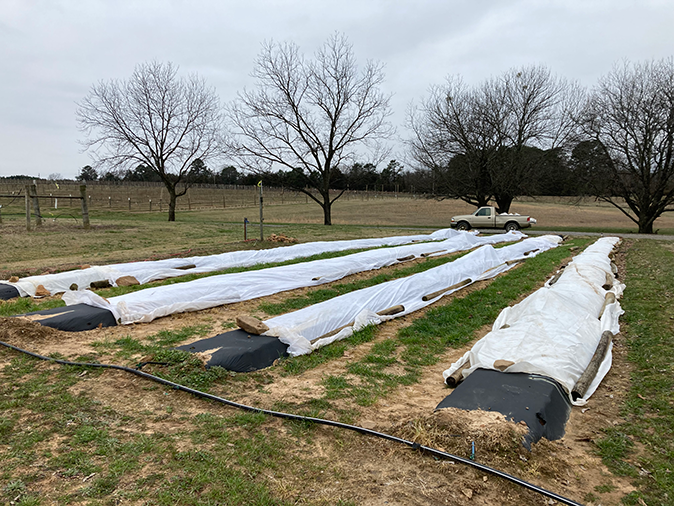Overnight freezing poses potential damage to Arkansas fruit
March 16, 2023
By Ryan McGeeney
U of A System Division of Agriculture
Fast Facts:
- Monday night’s cold snap expected to be followed by additional below-freezing temps Thursday into weekend
- Northwest Arkansas may see overnight low of 22 degrees on Sunday
- Strawberries, blackberries, blueberries particularly vulnerable right now
(500 words)
(Newsrooms: With art at https://flic.kr/p/2onv6fJ)
LITTLE ROCK — With the official start to spring less than a week away, winter is throwing
one last curveball at fruit growers in Arkansas and the surrounding region.
Below-freezing temperatures throughout much of the state made an appearance Monday night and Tuesday morning, with more cold weather on the way, particularly in the northwestern corner of the state.
The National Weather Service on Wednesday forecast temperatures in the 20s for Washington County beginning Thursday night, with an overnight low of 22 degrees Fahrenheit on Sunday. The plummeting temperatures are part of a major storm front expected to enter the state Thursday.
While below-freezing temperatures are never particularly welcome for many Arkansans, the timing is particularly worrisome for growers of strawberries, blackberries and blueberries. Amanda McWhirt, extension fruit horticulture specialist for the University of Arkansas System Division of Agriculture, said that blooms are currently visible on many strawberries.
“Strawberry blooms can be damaged at around 29 or 30 degrees, but a lot of growers use row covers, so that gives them a few extra degrees of protection when temperatures dip below that mark,” McWhirt said. “But the other thing that’s happening is that there are blooms on blueberries in some places, and blackberries have broken bud,” making the plants especially vulnerable to freeze damage when temperatures get into the low 20s.
About 200-300 acres each of strawberries, blackberries and blueberries are grown in Arkansas annually, McWhirt said. While the extent of damage caused by Monday night’s freeze is largely unknown at this point, growers need to take steps to protect their crops throughout the expected winter storm, she said.
“Producers can use row covers on certain crops,” she said. “In blackberries, they can use covers if they’re using the cross-arm rotating trellises. I’m recommending people put on their row covers now, especially as we’re likely to have rainfall, so growers need to get those on before it starts raining.”
As much as 2 inches of rain is expected in central and southern Arkansas on Thursday, potentially triggering flash flooding in several areas, according to the National Weather Service. Additionally, the likelihood of severe winds of 58 miles per hour or more is projected as high as 44 percent in southwestern Arkansas, with the probability of severe hail reaching 29 percent for the state’s westernmost tier of counties, from Sebastian to Miller County.
McWhirt, who co-authors the Arkansas Fruit, Vegetable & Nut Update Blog with several other Division of Agriculture horticulture specialists, said the key to protecting budding or blossoming fruits from cold weather damage is to know the thresholds of a given plant at a given stage and protect them when temperatures are expected to dip (or plunge) below those respective points. The Division of Agriculture offers many online resources for growers, including a chart of critical temperatures for several popular Arkansas fruit crops.
“In some areas, especially the northwest corner of the state, growers may want to consider double-covering — put two row covers on instead of just one,” McWhirt said.
To learn about extension programs in Arkansas, contact your local Cooperative Extension Service agent or visit www.uaex.uada.edu. Follow us on Twitter and Instagram at @AR_Extension. To learn more about Division of Agriculture research, visit the Arkansas Agricultural Experiment Station website: https://aaes.uada.edu/. Follow on Twitter at @ArkAgResearch. To learn more about the Division of Agriculture, visit https://uada.edu/. Follow us on Twitter at @AgInArk.
About the Division of Agriculture
The University of Arkansas System Division of Agriculture’s mission is to strengthen agriculture, communities, and families by connecting trusted research to the adoption of best practices. Through the Agricultural Experiment Station and the Cooperative Extension Service, the Division of Agriculture conducts research and extension work within the nation’s historic land grant education system.
The Division of Agriculture is one of 20 entities within the University of Arkansas System. It has offices in all 75 counties in Arkansas and faculty on five system campuses.
Pursuant to 7 CFR § 15.3, the University of Arkansas System Division of Agriculture offers all its Extension and Research programs and services (including employment) without regard to race, color, sex, national origin, religion, age, disability, marital or veteran status, genetic information, sexual preference, pregnancy or any other legally protected status, and is an equal opportunity institution.
# # #
Media Contact:
Ryan McGeeney
rmcgeeney@uada.edu
@Ryan_McG44
501-671-2120
